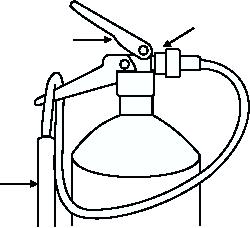
Some important facts you should remember about
CARBON DIOXIDE FIRE EXTINGUISHER
the operation and use of an AFFF extinguisher are as
The standard Navy CO2 fire extinguisher (fig. 5-3)
follows:
has a rated capacity (by weight) of 15 pounds of CO2.
1. The AFFF extinguisher is designed for use on
Removing the locking pin and squeezing the release
valve built into cylinder valve operates it. CO2
class BRAVO pool fires; however, it may also be used
extinguishers are primarily used on small electrical
on class ALPHA fires. AFFF is NOT recommended for
fires (class CHARLIE) and have limited effectiveness
use on class CHARLIE fires (energized electrical
on class BRAVO fires.
components).
2. Before attacking a fire, ensure the pressure
CYLINDER
within the cylinder is within the proper range, and
HANDLE
VALVE
remove the locking pin. To operate, squeeze the
operating lever above the carrying handle. The
extinguisher is capable of continuous operation or
multiple bursts.
3. AFFF extinguishes class ALPHA fires by
cooling. It is superior to water because AFFF has added
HORN
ASSEMBLY
wetting and penetrating ability. For small class ALPHA
fires, apply AFFF to the base (source) of the fire.
4. AFFF extinguishes a class BRAVO fire or
DCf0503
protects an unignited fuel spill by floating on the
Figure 5-3. 15-pound carbon dioxide fire extinguisher.
flammable liquid and forming a vapor seal. One AFFF
extinguisher will effectively extinguish 20 square feet
The steps of the procedure you should adhere to for
operating the CO2 extinguisher are as follows:
(4 1/2 feet by 4 1/2 feet) of flammable liquid fire. To
apply, start from 15 feet away and sweep the AFFF from
Step 1. Carry the extinguisher in an upright
side to side at the base of the fire. One AFFF
position and get as close to the fire as possible.
extinguisher can be used to vapor seal a fuel spill to
Step 2. Place the extinguisher on the deck and
prevent a fire up to 40 square feet (about 6 feet by 6 feet)
remove the locking pin from the valve.
in size. Larger fuel spills, or spills which are not fully
Step 3. Grasp the insulated handle of the horn.
accessible or visible, should be covered using 1 1/2-inch
Rapidly expanding CO2 causes the horn to become
AFFF hose or by the installed bilge sprinkling system.
quite cold.
5. Deep fat fryer fires often require special
Step 4. Squeeze the operating lever to open the
procedures to extinguish them. Combinations of AFFF
valve and release CO2. Direct the CO2 toward the base of
and PKP may be needed to put out these fires and
the fire. The maximum range of a 15-pound CO2
prevent their spread throughout the space or into
extinguisher is 4 to 6 feet from the outer end of the horn.
ventilation ducting. AFFF should only be directed at the
In continuous operation, the 15-pound CO2 extinguisher
back wall of the fryer, allowing the stream to flow onto
will be expended in approximately 40 seconds.
the surface of the burning oil. This technique does not
WARNING
disrupt the cooking oil and allows the fire to be put out
and a layer of foam to be developed over the oil.
Shock from static electricity can be
avoided if you ground the cylinder to the deck
WARNING
Do not direct AFFF directly into hot
Many ships have a CO2 transfer unit to recharge the
cooking oil because doing so can result in
15-pound cylinders from 50-pound CO2 cylinders in a
immediate boiling of the AFFF. This violent
well-ventilated space. The CO2 transfer unit (fig. 5-4)
boiling may result in hot cooking oil splashing
consists of an electric motor, a pump, a high-pressure
out of the fryer onto fire fighters.
hose, a control valve, adapters, and fittings. The transfer
5-3

